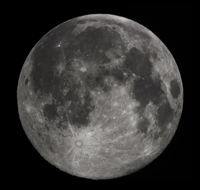Difference between revisions of "Moon"
(→Key Stage 3) |
|||
| Line 40: | Line 40: | ||
==Key Stage 3== | ==Key Stage 3== | ||
| + | ===Meaning=== | ||
| + | A [[moon]] is a large [[rock]] which [[Orbit|orbits]] a [[planet]]. | ||
| + | |||
| + | ===About Moons=== | ||
| + | : [[Moon]]s are natural [[satellite]]s [[orbit]]ing a [[planet]]. | ||
| + | : Most [[moon]]s are too small to have enough [[gravity]] to become round. They can be [[asteroid]]s that were captured into [[orbit]] by a [[planet]]s [[gravity]]. | ||
| + | : [[Mercury]] and [[Venus]] do not have any [[moon]]s. All other [[planet]]s have one or more [[moon]]s. | ||
| + | |||
| + | {| class="wikitable" | ||
| + | |+ The Moon orbiting [[Earth]]. | ||
| + | |[[File:TheMoon.png|center|200px]] | ||
| + | |} | ||
| + | |||
| + | {| class="wikitable" | ||
| + | |+ The two moons orbiting [[Mars]]. | ||
| + | |- | ||
| + | | style="height:20px; width:200px; text-align:center;" |Phobos | ||
| + | | style="height:20px; width:200px; text-align:center;" |Deimos | ||
| + | |- | ||
| + | |[[File:Phobos.png|center|200px]] | ||
| + | |[[File:Deimos.png|center|200px]] | ||
| + | |} | ||
| + | |||
| + | {| class="wikitable" | ||
| + | |+ The four largest moons of [[Jupiter]]. | ||
| + | |- | ||
| + | | style="height:20px; width:150px; text-align:center;" |Io | ||
| + | | style="height:20px; width:150px; text-align:center;" |Europa | ||
| + | | style="height:20px; width:150px; text-align:center;" |Callisto | ||
| + | | style="height:20px; width:150px; text-align:center;" |Ganymede | ||
| + | |- | ||
| + | |[[File:Io.png|center|150px]] | ||
| + | |[[File:Europa.png|center|150px]] | ||
| + | |[[File:Callisto.png|center|150px]] | ||
| + | |[[File:Ganymede.png|center|150px]] | ||
| + | |} | ||
| + | |||
| + | ==Key Stage 4== | ||
===Meaning=== | ===Meaning=== | ||
A [[moon]] is a large [[rock]] which [[Orbit|orbits]] a [[planet]]. | A [[moon]] is a large [[rock]] which [[Orbit|orbits]] a [[planet]]. | ||
Revision as of 20:22, 12 March 2019
Contents
Key Stage 2
Meaning
A moon is a large rock which orbits a planet.
About Moons
- If it goes around a planet and it was not made by humans then it is called a moon.
- The Earth has one moon called The Moon.
- Some planets have no moons like Mercury and Venus.
- Some planets have many moons. Jupiter has 67 moons.
Examples
| Phobos | Deimos |
| Io | Europa | Callisto | Ganymede |
Key Stage 3
Meaning
A moon is a large rock which orbits a planet.
About Moons
- Moons are natural satellites orbiting a planet.
- Most moons are too small to have enough gravity to become round. They can be asteroids that were captured into orbit by a planets gravity.
- Mercury and Venus do not have any moons. All other planets have one or more moons.
| Phobos | Deimos |
| Io | Europa | Callisto | Ganymede |
Key Stage 4
Meaning
A moon is a large rock which orbits a planet.
About Moons
- Moons are natural satellites orbiting a planet.
- Most moons are too small to have enough gravity to become round. They can be asteroids that were captured into orbit by a planets gravity.
- Mercury and Venus do not have any moons. All other planets have one or more moons.
| Phobos | Deimos |
| Io | Europa | Callisto | Ganymede |






